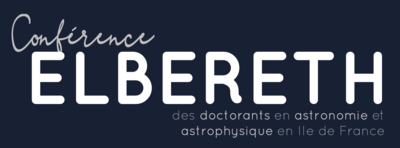Orateur
Description
Recent studies have shown that star formation rate is 10 to 100 times lower to precedent models. Different processes can contribute to gas heating and angular momentum addition into the cloud which disperse it and limits star formation. Radiative feedback from massive stars is one of the major mechanism and has a huge impact on their molecular cloud parent and interstellar matter. Stellar feedback can be probed by observations of Photon-Dominated Regions (PDRs) where massive stars far-ultraviolet (FUV) photons (i.e. 6eV $<$ E $<$ 13.6 eV) create warm regions of gas and dust photodestructed. OH enhanced by water photodissociation emits in mid-infrared. As Photon-Dominated Regions (PDRs) are illuminated by far-ultraviolet (FUV) radiation, OH lines might be detected in these regions. OH emission may be use to probe the local UV field, pressure and density of these regions. These lines might be detected by the Webb Space Telescope during its observation of PDRs. Our goal is to predict OH mid-IR lines enhanced by water photodissociation for a large range of pressure and UV field to understand the dependence of their intensity with these parameters. In order to predict OH lines, we use the Meudon PDR Code to compute the models. This code simulates their thermal and chemical structure. Then we use $\texttt{GROSBETA}$, which includes radiative pumping, collision excitation and desexcitation and prompt emission, to post-process the outputs. The influence of pressure and UV field on the integrated intensities is studied in details. Finally, we apply our study to the Orion Bar in order to evaluate the detectability of these OH mid-IR lines with the Webb Space Telescope. OH mid-IR lines can only be detected in very illuminated PDRs with high pressure: P$_{gas}$ > 5$\times$10$^7$ K.cm$^{-3}$ and G$_0$ > 10$^4$. However, their detectability depends a lot on the line-continuum ratio. They need to be high enough so that they can get out of the residual noise due to detectors. Moreover, these lines peak at the same position as the highly excited rotational lines (such as 0-0 S(3) and 0-0 S(4)) of H$_2$.
Day constaints
I can only present on 23rd afternoon and 25th.
| Field | InterStellar Medium |
|---|

